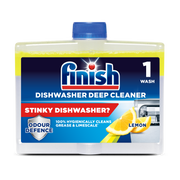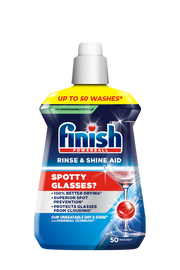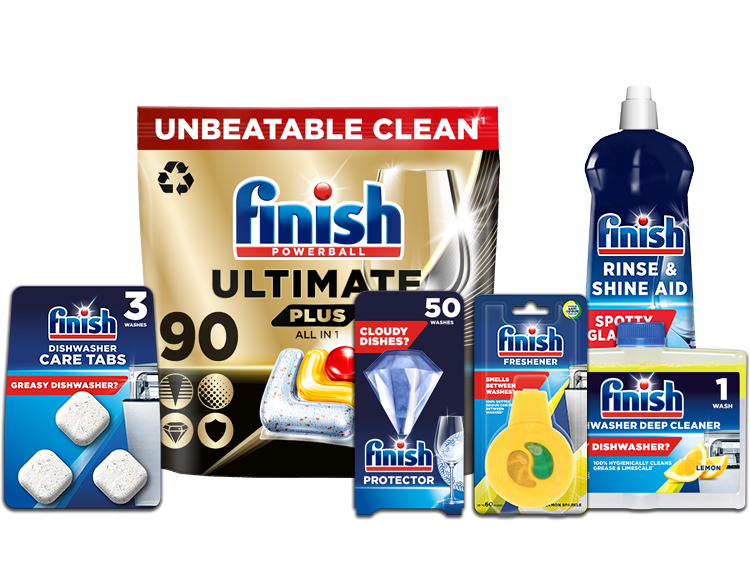
Dishwasher Salt

Dishwasher Salt is especially designed to prevent limescale build up in your dishwasher which can cause poor performance.
PRODUCT OVERVIEW
Dishwasher Salt is especially designed to prevent limescale build up in your dishwasher which can cause poor performance. Salt also effectively softens water to ensure better cleaning performance of your detergent, preventing white residue marks from hard water on your glasses and dishes.
PREVENTS LIMESCALE BUILD UP
SOFTENS WATER
PREVENTS WHITE RESIDUE MARKS FROM HARD WATER
FREQUENTLY ASKED QUESTIONS
Dishwasher salt is sodium chloride, the same chemical that makes up table and sea salts. You shouldn’t use table salt though as it is much finer and can block and cause damage to your dishwasher. Dishwasher salt granule size is larger and ensures the salt dissolves slower without blocking the softener unit.
Dishwasher salt doesn’t actually enter the dishwasher instead it flows through the softener unit before being drained with the waste water.
The way that dishwasher salt works is by providing sodium for the dishwasher’s ‘ion exchange resins’ that are in the softener. When regenerated by the sodium, these work to attract and trap the magnesium and calcium ions that cause hard water.
Dishwasher salt has much larger granules than regular salt in order to help them dissolve without a risk of creating a blockage which would result in malfunctioned softener unit. For finer salt the risk is real!
Prevents Limescale
Topping up dishwasher salt can lead to less limescale building up in your machine as it softens the water as it flows into the cleaning chamber. All in all, a better running machine also means there is less chance of other parts malfunctioning. You can ask your supplier for the hardness levels in your area and some can tell you through their website. It’s good to get into the habit of checking salt level regularly (i.e. once a month) and making sure that salt tank/reservoir is always filled. In some machines there would be a red light blinking when salt levels are low, please re-fill salt tank accordingly when that happens.
No more spots and watermarks
Spots and watermarks can become a constant problem without the use of Finish Dishwasher Salt. These marks can occur when the water is hard, causing detergent to perform less effectively. Since dishwasher salt effectively softens water, these heavy deposits of limescale will not accumulate in your dishwasher and will help keep your dishes looking cleaner.
Most machines have an indicator light that will go on when you switch your machine on to let you know it’s running low on dishwasher salt. If the light is not on, this usually means that your machine has enough salt to wash another load of dishes.
In terms of working out how much dishwasher salt your machine needs, ensure you check the packaging to find out how much salt you will need. It may help to use a measuring cup and a funnel to both measure out and supply the salt to your dishwasher. We recommend leaving the salt level approximately 1cm under the lip of where the cap will screw back on so you don’t overfill your machine and potentially waste your product.
It’s easiest to top up with dishwasher salt simply when your machine is empty, so after unpacking a clean load of dishes is the most suitable time.
Dishwasher salt needs to be added to an extra filter in your dishwasher. This is usually found in the base of the washing unit, as opposed to the door, but make sure to check your manufacturers guide or instruction manual to make sure. To add Finish dishwasher salt, open the cap and pour the salt in. Ensure you check the packaging to find out how much salt you will need, and it may help to use a measuring cup, and a funnel, to both measure out and supply the salt to your dishwasher.
If the reservoir for the salt is full of water, you can still pour the salt in as it will displace what is in there. If you don’t plan to run the machine immediately after refilling, it’s recommended to wipe out displaced water from the machine with a paper towel. If you run the machine for the first time make sure to fill salt reservoir with water - in order to regenerate softener unit salt must be in a solution. Always follow the instructions from manual provided by the machine manufacturer. Once poured, replace the cap, ensuring it is closed tightly and it should be ready to use again. Most water softeners will have an adjustable setting for water hardness, so make sure this is adjusted correctly to make sure that you get the perfect clean.
Remember to top up your dishwasher salt regularly if you notice it’s running low.
SAFETY & STORAGE
Store in a dry environment, away from heat and moisture
Keep away from children
Do not ingest
If product is ingested then seek medical advice
COMPLETE THE CLEAN
For the optimal dishwashing experience, why not try...
-
Dishwasher Cleaner
Removes grease and limescale from your machine.
-
Rinse & Shine Aid
To deliver shinier and drier dishes.























